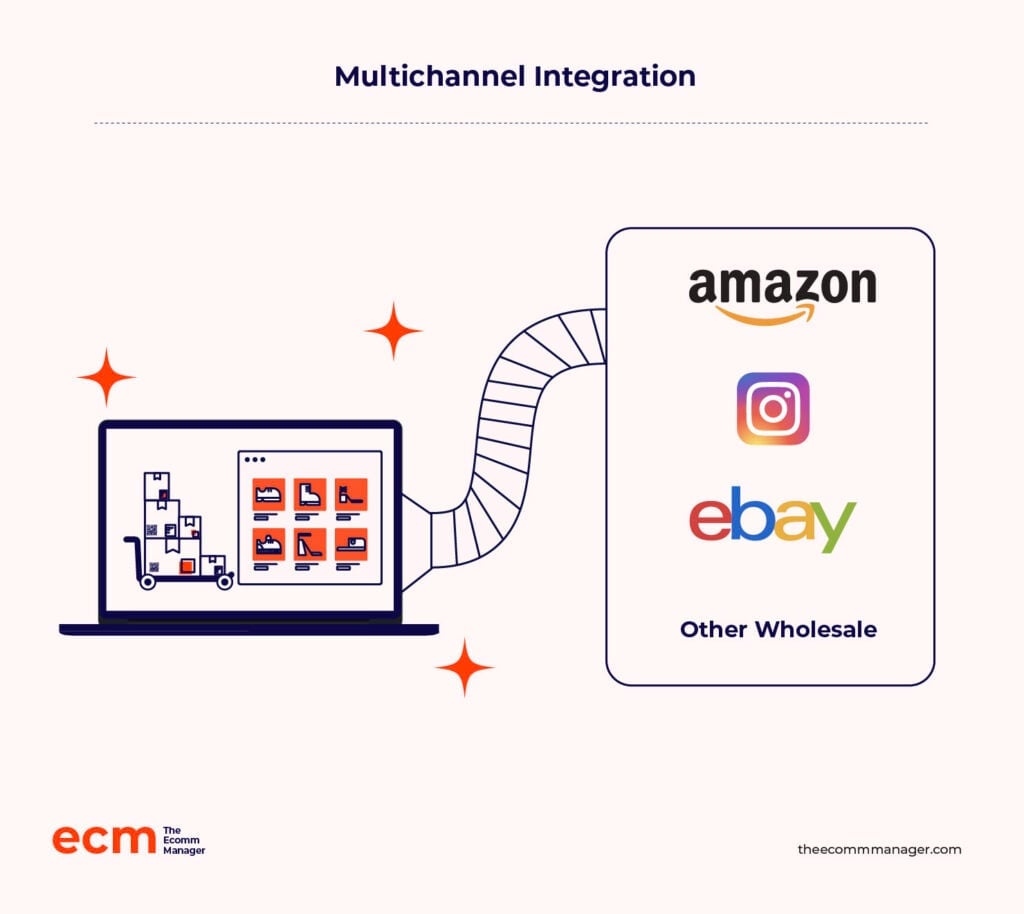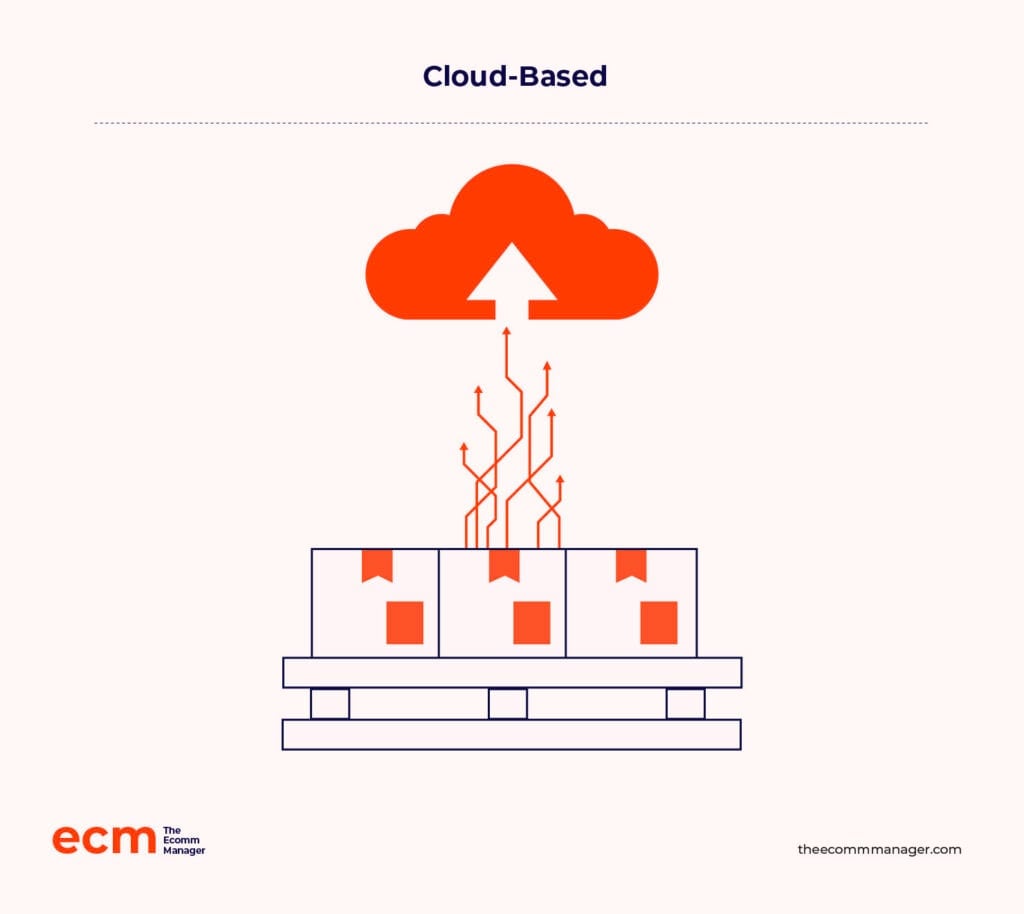Streamline Like a Pro: Inventory management software enhances ecommerce efficiency by optimizing stock levels and monitoring KPIs, which is crucial for smooth operations.
Growth Pathway Discovery: Assessing the business's needs and growth potential is vital when selecting the right inventory management tool.
The Flashy Simple Trap: Appearances can be deceiving! Initially appealing inventory solutions may lack critical features necessary for long-term success.
Inventory management software helps ecommerce brands streamline their operations, optimize stock levels, monitor key performance indicators (KPIs), and much more.
Kinda important stuff, yeah?
Online stores, when choosing such a tool, should carefully analyze their needs and growth trajectory.
An inventory management solution with limited features may appear attractive at first due to its simplicity and affordability.
However, its advantages could quickly vanish as you grow, whether you’re serving more areas or expanding your catalog.
You should examine all the offerings of inventory management software before considering a specific tool for implementation. This is crucial in finding out if the solution under consideration has all the capabilities you need.
In this article, we’ll look at 29 such capabilities that are deemed must-haves for ecommerce inventory systems.
29 Essential Inventory Management System Requirements
As mentioned earlier, each ecommerce store has different needs and growth strategies that necessitate an inventory management system to compliment them.
For instance, an online shop selling internationally will look for features that simplify cross-border shipment tracking.
Similarly, if an established ecommerce brand has multiple warehouses, an inventory management system that provides stock updates in real time across all locations is a must.
If you’re serious about finding the right inventory management software for your online store, you might want to mark the relevant requirements as you go through the list below to ease your process.
1. Real-time inventory tracking
Without real-time tracking, you’re flying blind. Accurate, always-on inventory visibility helps ecommerce teams avoid overstocking, reduce carrying costs, and stay in sync with fluctuating demand.
This isn’t just about knowing what’s on the shelf—it’s about making faster, smarter decisions.
- Adapt to market volatility. With inflation, supply chain shocks, and shifting customer preferences, static inventory models just don’t cut it. Real-time tracking helps you respond in the moment—not after it’s too late.
Cash flow is the lifeblood of any business… but current economic conditions—like inflation, labor issues, and supply chain disruptions—continue to challenge… retailers’ ability to plan inventory.
Unfortunately, small and mid-sized businesses (SMBs) are among the most vulnerable, as they often don’t have large cash reserves and increasingly struggle to secure access to credit amidst the recent banking industry crisis.
As companies navigate the high cost of borrowing in an effort to normalize inventory levels, seeking enhanced cash flow solutions through strategic supply chain management can aid in growth.
- Support just-in-time strategies. Stocking “just enough” reduces waste and frees up working capital. (See requirement #7 for more on JIT.)
- Optimize storage costs. Avoid paying for warehousing space you don’t need by syncing stock levels to current demand.
Real-time tracking is foundational—it powers everything from automated reordering to accurate demand forecasting.
2. Multichannel integration

A lot of ecommerce businesses sell their products on various channels—marketplaces, social platforms, wholesale, etc.
For instance, it's not uncommon for companies to have their own online store and also sell their products on ecommerce marketplaces like eBay, Etsy, and Amazon.
Multichannel integration capabilities in inventory management systems make it easier to manage stock levels across all platforms. These systems synchronize inventory in real time, preventing overselling and stockouts.
Complete visibility across these channels streamlines logistics and fulfillment, enabling quicker response times and reducing errors.
This level of integration is crucial for maintaining accurate stock levels, optimizing order processing, and ultimately, enhancing customer satisfaction.
3. Order management and fulfillment
Order management and fulfillment encompass everything that happens after a customer completes a purchase until they receive their package. Customer expectations are high.
Fulfillment delays or shipping mistakes don’t just hurt your ratings—they crush trust.
A well-integrated inventory system smooths out the entire post-purchase experience:
- Automated order routing. Orders flow directly to fulfillment teams with pre-picked inventory and packing instructions.
- Streamlined returns. A return shouldn’t throw your inventory count out of whack. Integrated returns and exchange workflows make restocking effortless.
- Inventory sync across stages. From picking and packing to shipping and returns, stock levels stay accurate throughout the process.
This level of coordination is key to fast delivery, accurate stock counts, and happy customers who come back.
4. Warehouse management
Warehouses store inventory until it's picked and shipped to fulfill customer orders.
Warehouse management encompasses all processes related to inventory tracking, order processing, picking, packing, and shipping orders. It ensures products are organized for efficient storage, accurate stock level maintenance, and fast, precise order fulfillment.
Moreover, it also guides teams to move inventory around as needed (called “transfer management”).
Such functionalities, when integrated within your inventory management solution, can drastically improve productivity and operational efficiency.
5. Supply chain management
Your inventory isn’t just sitting in a warehouse—it’s moving through a complex web of vendors, shipping partners, and fulfillment nodes. And if you’re not tracking all of it in real time, you’re leaving room for errors and delays.
Strong inventory tools give you end-to-end visibility:
- Track inventory in transit. Know what’s delayed, what’s en route, and what’s stuck at customs—before it becomes a customer problem.
- Improve forecasting accuracy. Better data on lead times and vendor performance feeds into smarter demand planning.
- Reduce error rates. Real-time syncing across locations minimizes discrepancies and double-handling.
In a world of fragile logistics, tight supply chain integration is your best hedge against disruption.
6. Demand forecasting

Demand forecasting is essential for predicting future product demand based on historical data and market trends.
An advanced inventory management system should provide robust demand forecasting capabilities to enable data-driven decision-making and optimized inventory control.
By analyzing past sales records and current market trends, the software can precisely forecast customer demand for specific products.
This demand intelligence aids in planning optimal inventory levels to prevent both stockouts and excess overstock situations.
With precise demand forecasting, brands can make certain they have the right products in the right quantities at the right locations and times.
7. Just-in-time inventory
Operating with razor-thin inventory levels takes precision.
That’s the premise behind just-in-time (JIT): keeping stock lean by ordering only what’s needed, when it’s needed.
For ecommerce businesses, JIT can cut holding costs significantly—if your systems are dialed in. It works best when forecasting, supplier coordination, and inventory tracking are tightly integrated.
JIT strategies benefit from:
- Accurate demand forecasting to avoid stockouts during high-volume periods.
- Reliable supplier timelines—small delays can ripple into missed deliveries.
- Real-time stock visibility so teams can act immediately on changes.
JIT can be powerful, but it’s not for every product. Use it selectively on high-turnover, low-margin items where overstocking hurts more than it helps.
8. Product categorization
Your catalog isn’t just for shoppers—it powers everything behind the scenes, too. The way you label and group your products determines how efficiently your team can track, reorder, and report on inventory.
Look for systems that support:
- Flexible categorization by size, color, configuration, bundles, and more.
- Custom tags or hierarchies to reflect how your business actually sells (seasonal collections, kits, etc.).
- Built-in compatibility with ABC analysis and cycle counting workflows to focus on high-value or fast-moving items.
Smart categorization does more than organize products—it shapes customer experience, speeds up fulfillment, and drives better insights across your business.
9. Barcode scanning

Barcodes, or scan codes, encode machine-readable product information in an ecommerce store's catalog. Inventory management software with integrated barcode scanning capabilities can significantly enhance operational efficiency.
Tasks like stock entry, package tracking, and processing returns become seamless and automated across the customer, store, and supplier touchpoints.
Barcode scanning virtually eliminates manual errors, making inventory management more accurate and efficient.
This technology streamlines workflows, reduces time spent on manual data entry, and ensures real-time inventory updates.
10. Reporting and analytics
So far, we have mentioned terms and phrases like “demand forecasting” and “market trends” reflecting the importance of data.
This is where robust reporting and analytics features in an inventory management solution become indispensable.
A few crucial metrics that you can track include:
- Stock levels: Current quantity of each item in inventory.
- Reorder points: Threshold levels that trigger restocking.
- Turnover rate: Frequency at which inventory is sold and replaced.
- Lead time: Time taken for an order to be received after placement.
- Carrying costs: Total costs of holding inventory over a period.
- Order accuracy: Percentage of orders fulfilled without errors.
- Backorder rate: Frequency of out-of-stock items leading to delayed orders.
Intuitive reporting tools within the inventory system help monitor these KPIs, allowing businesses to execute data-driven strategies and quickly adapt to market changes.
By leveraging these valuable insights, companies can optimize inventory levels, reduce costs, and enhance overall operational efficiency.
11. Batch and expiry tracking
Batch and expiry tracking capabilities in an inventory management system are crucial for monitoring product serial numbers and expiration dates.
This prevents stockouts of perishable items and reduces waste by ensuring time-sensitive products are used or sold within their shelf life.
Tracking batch numbers and expiry dates is essential for upholding consumer trust, maintaining product quality, and complying with health and safety regulations.
When integrated into the inventory tracking software, these features enable timely notifications about impending expirations, allowing ecommerce teams to take necessary action.
12. Automated ordering and reordering
Reordering shouldn't be a manual task. If your inventory system doesn’t support automated purchasing rules, you’re wasting time and increasing the risk of human error.
Here’s what a solid auto-reorder setup should include:
- Trigger-based rules tied to real-time stock levels, lead times, and reorder points.
- Custom order quantities based on EOQ models or sales velocity.
- Approvals or workflows that let ops teams review before confirming POs.
Note: This overlaps with requirement #29, so make sure the two work together, not in isolation.
13. Inventory alerts
Inventory alerts are notifications that inform managers when stock levels are running low, prompting timely action to replenish inventory and prevent stockouts.
These alerts help maintain optimal stock levels, ensuring sufficient inventory is available to meet customer demand.
Alert configurations can provide real-time updates, enabling businesses to respond quickly to changes in inventory status.
This proactive approach to inventory control helps avoid potential disruptions in the supply chain.
14. Mobile accessibility

Ecommerce teams are often on the move, traveling between warehouses, manufacturing plants, fulfillment centers, and other operational sites. This mobility can make it challenging to stay updated on real-time inventory status.
Inventory management software with robust mobile apps solves this issue by providing instant access to stock level updates from anywhere.
This on-the-go accessibility facilitates efficient transfer management and improves collaboration across distributed teams.
With mobile capabilities, teams can monitor and manage inventory seamlessly from any location, ensuring uninterrupted operations and enabling better decision-making while on the move.
15. Customization and scalability
No two ecommerce businesses are identical—your ideal inventory system needs to reflect that. Custom fields, modular workflows, and adjustable permissions let teams mold the platform to fit how they actually operate.
Even more important? Scalability.
As your catalog grows or you enter new markets, the platform shouldn’t slow you down. Look for systems that:
- Support multiple warehouses or regions.
- Handle large SKU volumes without crashing reporting.
- Integrate with new tools as your tech stack evolves.
Scalability isn’t a future problem—it’s a current requirement for high-growth brands.
16. Security and user permissions
Inventory management software handles sensitive data such as vendor information, customer details, and proprietary product specifications.
Protecting this critical data from unauthorized access or modification is paramount.
A robust solution should implement secure login protocols and allow administrators to assign specific user roles and permissions.
This role-based access control ensures sensitive data is only accessible to authorized personnel, increasing vendor and customer confidence while maintaining compliance with data security regulations.
17. Supplier and sourcing management
Effective supplier and sourcing management is critical for ensuring a timely and cost-efficient supply of goods.
This involves monitoring supplier performance, negotiating terms, and ensuring the quality and cost-effectiveness of raw materials or products sourced.
An integrated inventory management solution with robust supplier and sourcing capabilities can simplify these processes. It streamlines tasks like logistics tracking, purchase order management, and maintaining optimal inventory levels across suppliers.
This leads to stronger supplier relationships and smoother overall operations.
18. Purchasing
Once a reorder point is hit, the purchasing process begins. The right system should make that handoff seamless—no spreadsheets, no guesswork.
Expect tools that can:
- Pull accurate SKU, vendor, and pricing data directly into the PO.
- Track approvals and confirmations.
- Sync with finance systems to avoid payment delays.
Clean execution here keeps inventory moving and vendor relationships intact.
19. Deployment
Inventory management is one critical component of an ecommerce business, operating alongside finance, accounting, sales, customer relationship management (CRM), and other core functions.
To enable seamless collaboration across these interconnected areas, many businesses adopt comprehensive enterprise resource planning (ERP) systems.
ERPs consolidate data from multiple tools and sources into a centralized repository, creating a single source of truth for the organization.
Deploying the inventory management solution as an part of an overarching ERP allows for seamless data sharing and integration with existing ecommerce platforms and processes.
This centralized approach optimizes the inventory management capabilities by ensuring consistent data access, smooth cross-functional collaboration, and enhancing overall business performance through enterprise-wide process synchronization.
20. Integrations
Inventory doesn’t live in a silo—it connects with sales, shipping, accounting, and customer service. The right platform should make those connections effortless.
Critical integrations include:
- POS systems (for brick-and-mortar or pop-ups)
- Shipping carriers for tracking and rate shopping
- Accounting platforms to sync purchasing and cost data
- CRMs to track product preferences or issues at the customer level
Bonus points if it offers open APIs or native plug-ins for your ecommerce platform.
21. Dropshipping
Ecommerce businesses built on the dropshipping model rely on third-party suppliers or manufacturers for order fulfillment. When offering a wide range of products, these companies often work with multiple suppliers simultaneously.
Managing inventory accurately across numerous suppliers can become complex and labor-intensive.
Teams may need to manually communicate stock updates to each vendor, slowing down operations and increasing the risk of avoidable errors.
Inventory management solutions with robust dropshipping integration capabilities can mitigate these challenges. With seamless supplier connectivity, ecommerce businesses can instantly inform their suppliers about real-time market demand with a few clicks.
This streamlined communication boosts overall process efficiency and enhances customer satisfaction through reliable order fulfillment.
22. Cloud-based

While on-premises or open source inventory management software may offer cost advantages and data ownership, they often come with significant drawbacks such as infrequent maintenance, limited capabilities, and lack of accessibility for distributed teams.
In contrast, cloud-based solutions make inventory management seamless, even for ecommerce teams spread across multiple locations.
These solutions provide consistent support, regular product updates, and evolve with changing business requirements, ensuring your system remains up-to-date and aligned with your needs.
This model ensures your inventory management capabilities remain current, efficient, and capable of supporting future growth without friction.
23. Customer support
As you can garner from this list, modern inventory management systems pack a wide array of features and functionalities.
This can make it challenging for new team members to quickly adapt to established workflows. Additionally, running into issues or needing assistance while performing critical tasks is common when using cloud-based solutions.
Choosing an inventory management platform that provides reliable, hands-on customer support can protect your ecommerce team from such potential roadblocks.
Whether learning about a new feature or troubleshooting an issue, knowing that expert assistance is just a message or call away provides reassurance and peace of mind.
24. User-friendly interface
An intuitive and user-friendly interface allows team members to efficiently navigate the software, perform tasks quickly, and minimizes the need for extensive training.
New team members can explore the tool's capabilities independently, without spending excessive time on training materials or heavily relying on experienced colleagues for guidance.
This ease of use enhances team collaboration, workflow optimization, and continuous process improvement.
A well-designed, user-friendly interface ultimately boosts productivity and ensures a smoother onboarding and adoption experience across your organization.
25. Multi-currency and multi-language support
If you’re selling globally, your inventory system needs to operate globally.
That means more than just accepting international payments—it requires infrastructure that supports multi-currency and multi-language operations across your entire supply chain.
Here’s what that really looks like in practice:
- Currency localization. Prices, costs, and purchase orders need to reflect regional currencies. Look for platforms that support automatic conversion with up-to-date exchange rates, and allow for custom pricing rules by region.
- Cross-border vendor support. Working with international suppliers? Your system should allow POs, invoices, and order statuses to be handled in each vendor’s native currency—with audit trails for finance teams to reconcile everything cleanly.
- Language adaptability. Teams across multiple regions—warehouse staff, 3PLs, or procurement partners—should be able to interact with the system in their preferred language. That cuts onboarding time and reduces operational errors.
- Timezone and region logic. Whether it’s sending out reorders, confirming inventory transfers, or syncing stock availability, a global operation means you’re coordinating across time zones. Your system should schedule and display everything in local context.
Expanding internationally without these features leads to friction at every turn—miscommunication, accounting delays, and fulfillment breakdowns. Multi-currency and language capabilities don’t just support expansion—they enable it.
26. Inventory classification and tracking techniques
Treating all inventory the same is a fast track to inefficiencies, waste, and missed revenue.
That’s why classification and tracking systems are essential—especially as your SKU count grows or you handle perishables, bundles, or multiple fulfillment centers.
Here’s how ecommerce teams stay organized and proactive:
- SKU management. SKUs (stock keeping units) help businesses identify, track, and analyze products across channels and locations. Clean, structured SKU systems make reporting, reordering, and cycle counting significantly easier.
- FIFO and FEFO. First-in, first-out (FIFO) and first-expired, first-out (FEFO) are inventory rotation techniques that ensure older or time-sensitive stock is used first. They’re especially critical for preventing spoilage and ensuring compliance in industries like food, cosmetics, and healthcare.
- Batch tracking. Assigning lot or batch numbers allows for complete traceability across the supply chain. If there’s a product defect or recall, you can isolate just the affected batch—no need to nuke your entire stock.
- ABC analysis. This technique groups inventory based on impact:
- A-items: High-value, low-quantity—require close monitoring and frequent reorders.
- B-items: Mid-value, mid-frequency—review regularly.
- C-items: Low-value, high-quantity—automate and streamline where possible.
Applying these methods helps ecommerce brands prioritize their efforts, reduce waste, and maintain accurate inventory visibility across even the most complex catalogs.
27. Cost management in inventory
Inventory doesn’t just sit on a shelf—it ties up cash, consumes space, and creates hidden costs that can quietly erode your margins if you’re not careful.
Smart inventory management requires understanding the full financial picture, not just how much product you have.
There are three core inventory cost buckets every ecommerce team should track:
- Ordering costs. These include everything involved in placing and receiving a purchase order—admin time, shipping fees, payment processing, and supplier minimums. Ordering in small batches too often can balloon this cost unnecessarily.
- Holding costs. This is the price you pay for storing inventory: warehousing, insurance, depreciation, utilities, and even shrinkage. Overstocking slows cash flow and adds to these overheads without driving sales.
- Shortage costs. When you run out of stock, the costs go beyond lost sales. You risk customer dissatisfaction, backorders, or having to pay a premium for emergency restocking—all of which hurt profitability and brand trust.
The best inventory systems don’t just track these costs—they help reduce them. Tools that calculate economic order quantity (EOQ), automate reorder points, and surface carrying cost trends can empower ecommerce teams to make smarter, leaner decisions.
Inventory should be an asset, not a liability, similar to vendor managed inventory practices. Managing these costs proactively keeps your business agile and your margins healthy.
28. Automation and machine learning for smarter inventory
Inventory management has come a long way from spreadsheets and manual counts. The future? It’s automated, predictive, and—honestly—already here.
Ecommerce brands using automation and machine learning (ML) are making faster, sharper decisions with less guesswork.
Here’s what that looks like in practice:
- Automated workflows. Modern systems automatically trigger reorders, sync stock across channels, update warehouse pick lists, and alert teams to exceptions—no human babysitting required. This reduces errors and frees up your ops team for more strategic work.
- Demand forecasting with ML. Machine learning algorithms analyze historical sales, seasonality, promotions, and external factors (like weather or regional events) to predict future demand. That means more accurate forecasts and fewer “oops we’re out” moments.
- Smart recommendations. AI-powered systems can suggest which products to restock, which to bundle or discount, and even help flag underperforming SKUs. Think of it as an always-on analyst helping you tune your inventory mix.
- Virtual agents and customer insights. Some platforms now offer AI chatbots that surface inventory data to customers in real time—“Yes, it’s in stock at our LA warehouse.” Others use behavior data to recommend stock levels by customer segment or geography.
The takeaway? Automation reduces the heavy lifting, while machine learning sharpens your edge. Together, they help ecommerce brands move from reactive to predictive—and that’s where the real gains live.
29. Optimized purchase order management
Purchase orders are more than paperwork—they’re how you control costs, prevent stockouts, and keep fulfillment flowing.
The best inventory management systems don’t just automate POs—they optimize them using real-time insights, supplier data, and demand trends.
Here’s what that looks like:
- Minimum stock level logic. Instead of static reorder points, optimized systems adjust based on sales velocity, seasonality, and supplier lead times. This prevents overordering and last-minute scrambles.
- Automated PO generation. When stock hits the threshold, the system generates and sends POs directly to suppliers—no email chains, no delays.
- Supplier performance data. Good systems track supplier reliability, shipping timelines, and fulfillment accuracy, so you can make smarter sourcing decisions and avoid weak links in your supply chain.
- Market- and competitor-aware planning. Some advanced systems incorporate market trends or even competitor behavior (e.g. sellout patterns) into their PO logic, helping you stay stocked when demand spikes unexpectedly.
When PO management is optimized, you're not just keeping shelves full—you’re buying smarter, responding faster, and building a supply chain that can scale with you.
Choosing Your Inventory Management Software By Features
Selecting the right inventory management software involves evaluating features against your business needs. Use the 25 essential features listed above to narrow down your options.
Here’s a short list of top inventory management software based on the features discussed:
Final Thoughts
A well-designed inventory management software can simplify various action items and processes related to maintaining optimal stock levels,coordinating with vendors, improving team collaboration, and driving overall operational efficiency.
When evaluating the myriad of available solutions in the market, ecommerce teams must carefully select a platform that not only addresses their immediate needs but also has the scalability and flexibility to accommodate evolving requirements as the business grows.
Finally, professionals also need to stay updated on the latest industry trends, market shifts, and technologies to continually iterate their workflows around inventory management.
Retail never stands still—and neither should you. Subscribe to our newsletter for the latest insights, strategies, and career resources from top retail leaders shaping the industry.




